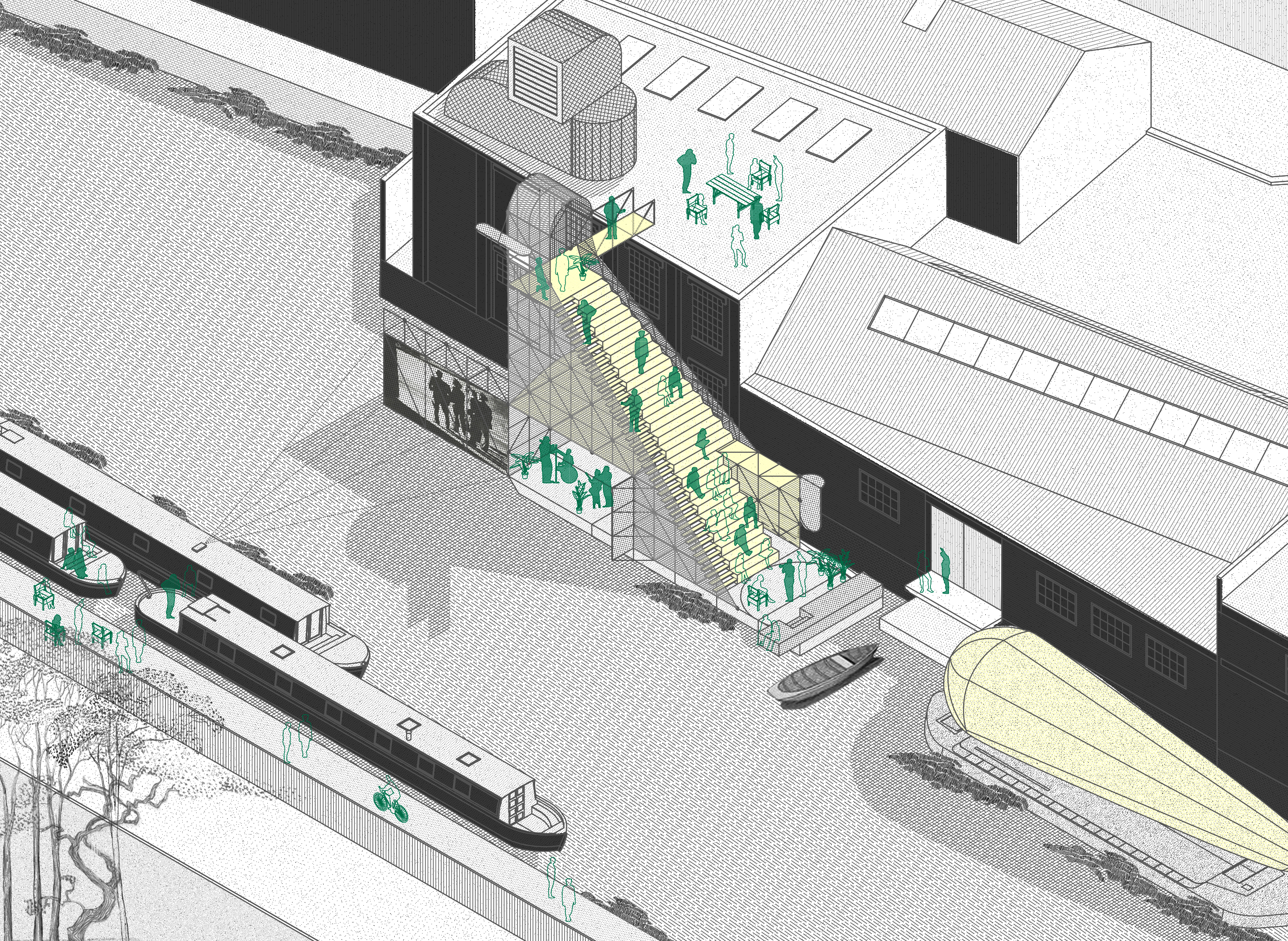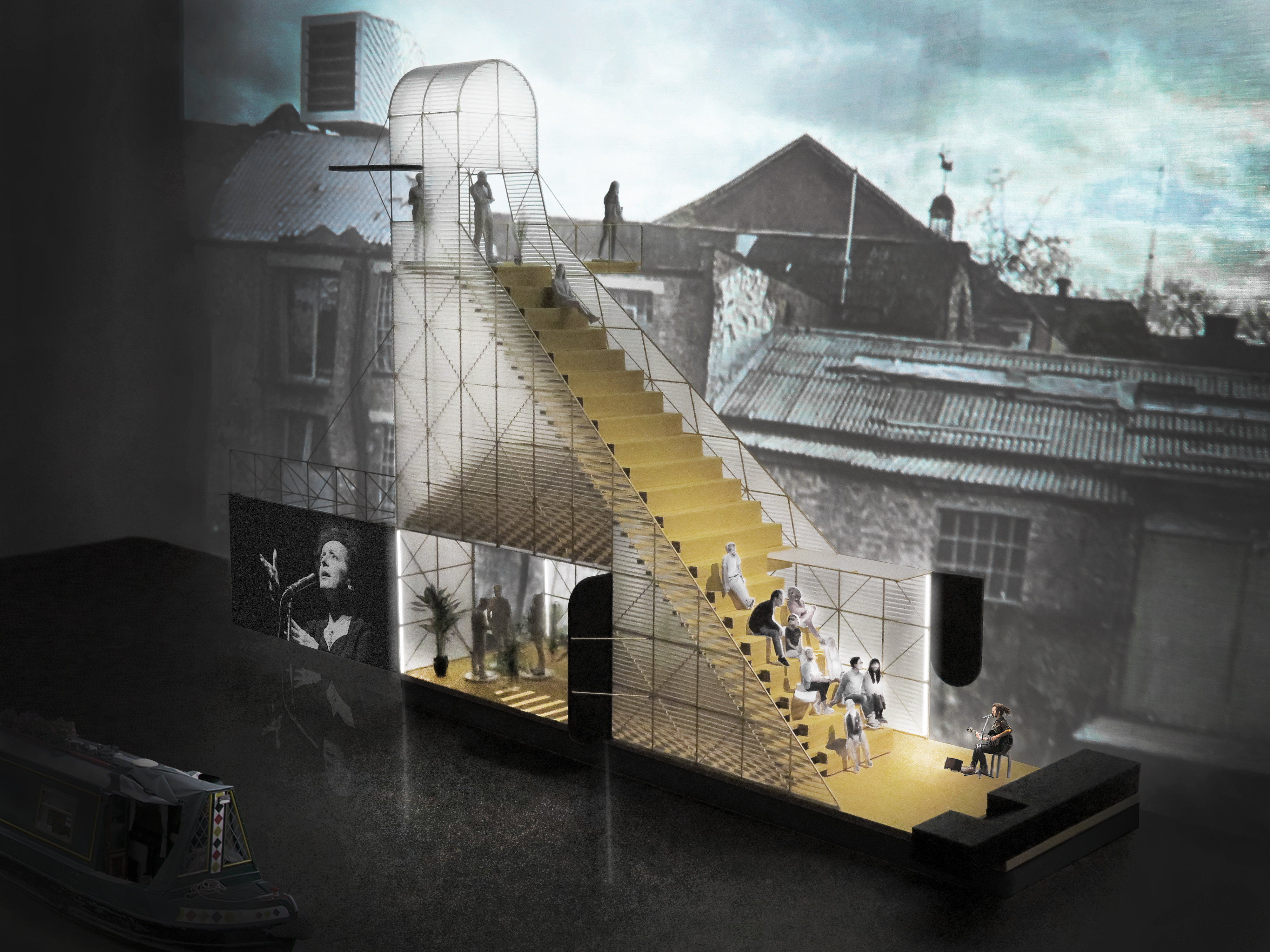Ante-Pavillion / Regent’s Canal Competition
“Instructions on How to Climb a Staircase Pavilion”
“Instructions on How to Climb a Staircase Pavilion”

Concurso
Ante-Pavillion · Regent’s Canal Competition
Nombre del Proyecto
Instructions on How to Climb a Staircase Pavilion
Ubicación
London, England
Año
2020
Realizadores
Rodrigo Fernández + Cristóbal Riffo + Francisco Cruz + Eugenio Mandiola

‘No one will have failed to observed that frequently the floors bends in such a way that one part rises at a right angle to the plane formed by the floor and then the following section arranges itself parallel to the flatness, so as to provide a step to a new perpendicular, a process which is repeated in a spiral or in a broken line to highly variable elevations.’
REGENT’S CANAL HAS BEEN A
SILENT WITNESS OF AN INDUSTRIAL
CHOREOGRAPHY PERFORMED BY CRANES,
BOATS AND LOCKS. A RESTLESS SHOW
OF WANDERING OBJECTS, GOODS AND
ARTEFACTS.
‘Ducking down and placing the left hand on one of the vertical parts and the right hand upon the corresponding horizontal, one is in momentary possession of a step or stair.’
AS CAPITALISM EVOLVED, THIS
PRODUCTIVE MILIEU GRAVITATED FROM
ITS EXHAUSTED INDUSTRIAL ORIGINS
TOWARDS NEW CREATIVE ENTERPRISES.
ALTHOUGH, SHIFTING INTO A HERMETIC
AND FIXED LANDSCAPE THAT NEGLECTS
THE CANAL’S WATER.

‘Each one of these steps, formed as we have seen by two elements, is situated somewhat higher and further that the one prior, a principle which gives the idea of a staircase, while whatever other combination, producing perhaps more beautiful and picturesque shapes, would be incapable of translating one from the ground floor to the first floor.’
THE PROPOSAL RECLAIMS THIS
FORGOTTEN INDUSTRIAL HERITAGE
TO ENVISION A VIBRANT OBJECT,
THAT HOUSES PERFORMANCES, MOVIE
SCREENINGS, COMMUNITY ACTIVITIES
AND SOME HUMBLE STEPS TO ENJOY THE
SUMMER EVENINGS RESTING ABOVE THE
BREEZE.
‘You tackle a stairway face on, for it you try it backwards or sideways, it ends ups being particularly uncomfortable. The natural stance consists of holding oneself upright, arms hanging easily at the sides, head erect but not so much so that the eyes no longer see the steps immediately above, while one tramps up, breathing lightly and with regularity.’
SLIDING PANELS, PIVOTING DOORS,
PULLEYS AND WIRES TRANSFORMS
INCESSANTLY THIS LIGHT AND
TRANSLUCENT GIANT, BY THE
UNPREDICTABLE ACTIONS OF ITS
CURIOUS VISITANTS.

‘To climb a staircase one begins by lifting that part of the body located below and to the right, usually encased in leather or deerskin, and which, with a few exceptions, fits exactly on the stair. Said part set down on the first step (to abbreviate we shall call it ‘the foot’), one draws up the equivalent part on the left side (also called ‘foot’ but not to be confused with ‘the foot’ cited above), and lifting this other part to the level of ‘the foot’ will rest on the first.’
PEOPLE STROLLS UP AND DOWN BY THESE STEPS THAT CONNECTS THE FACTORY ROOFS WITH THE CANAL’S WATER, DISCLOSING BY THIS VIBRANT MOVEMENT ALL THE FEATURES OF THE CREATIVE INDUSTRIES THAT WERE HITHERTO HIDDEN WITHIN THESE BRICKS FACADES.
‘(The first steps are always the most difficult, until you acquire the necessary coordination. The coincidence of names between the foot and ‘the foot’ makes the explanation more difficult. Be especially careful not to raise, at the same time, the foot and ‘the foot.’)’
‘INSTRUCTIONS ON HOW TO CLIMB A STAIRCASE’ PAVILION, DRAWS SIMULSTANEOSLY FROM THE PAST AND THE PRESENT, HACKNEY’S COMMUNITY AND ITS NEW RESIDENTS, TO PROVIDE A SITE FOR CASUAL ENCOUNTERS AND SPARK MUCH NEEDED CONVERSATIONS. AS WE ALL KNOW, STAIRCASES AND PAVILIONS ARE NOTHING MORE THAN UNEXPECTED SPACES TO MEET AND MINGLE WITH PEOPLE.
‘Having arrived by this method at the second step, it’s easy enough to repeat the movements alternatively, until one reaches the top of the staircase. One gets off it easily, with a light tap of the heel to fix it in place, to make sure it will not move until one is ready to come down.’
Julio Cortázar, ‘The Instructions Manual’




